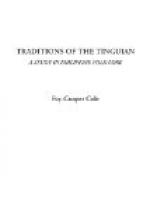We have seen that, for the most part, the life, customs, and beliefs which appear in our reconstruction of “the first times” agrees closely with present conditions; certain things which seem formerly to have been of prime importance—such as the sending of a betel-nut covered with gold to invite guests to a festival or ceremony—appear to have their echo in present conditions. The betel-nut which played such a momentous part in the old times still holds its place in the rituals of the many ceremonies, although it is not now much used in daily life. The magic of to-day is less powerful than formerly, but is still a tremendous force. The communication of the ancient people with other members of the animate world, as well as with the inanimate and spiritual, and their metamorphosis into animals and the like, offers nothing strange or inconsistent to the people of to-day. They even now talk to jars, they converse with spirits who come to them through the bodies of their mediums, and people only recently deceased are known to have had the power of changing themselves, at will, into other forms.
In short, there is no sharp break between the mode of thought of to-day and that exhibited in the folklore. It is true that the tales give sanction to some things not in agreement with Tinguian usage—such, for instance, as the marriage of relatives, or the method of disposing of the dead—and it may be that we have here a remembrance of customs which long ago fell into disuse.
In a previous paper [83] the writer showed that there have been many migrations into Abra from the north, south, and west. A part of the emigrants have become thoroughly amalgamated with the Tinguian people and have doubtless introduced some part of their material culture and beliefs. This helps us to understand such conflicts as we have already noted in regard to the place held by thunder and lightning in the spirit world, as to the future abode of the spirits of the departed, as well as other discrepancies which the limits of this paper have prevented us from discussing.
It is not impossible that those customs of “the first times,” which are at variance with those of to-day, may represent older ideas which have been swamped, or, on the other hand, the memory of the strange customs once practiced by the emigrants may have caused them to be attributed to the people of the tales.
Finally, we believe that a study of Tinguian mythology has shown us that we can gain a real knowledge of the past of a people through their folklore; that we can secure an insight into their mental life; and can learn something of the valuation they attach to certain of their activities and beliefs, which to us may seem at the surface trite and trivial.
Tales of the Mythical Period
1




